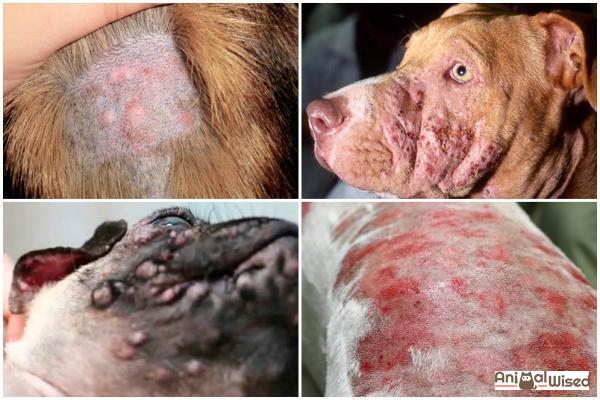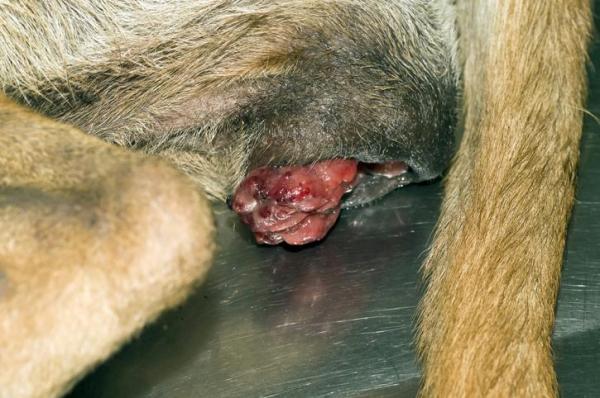
If we can see a bump or lumps on our female dog's privates, we may grow concerned. The first thing that likely drew our attention is observing that our dog is licking their genitals more than usual. Unfortunately, this action can aggravate the problem further, even if the dog is only trying to relieve some of the frustration. This is why contacting the veterinarian promptly is so vital. Lumps on the vagina, or more specifically the vulva, can be very serious.
This AnimalWised article explains why my dog has a bump on her private area. We look at the possible causes of spots, lumps or any alteration to their genitals. They range from relatively benign conditions to medical issues which can seriously threaten their well-being. If in any doubt when you see bumps on your dog's vulva, you need to go see a specialist ASAP.
Contact dermatitis
There are different types of dermatitis in dogs, all of them involving inflammation of the skin. Some types will result in bumps or hives which can be very irritating for the animal. Contact dermatitis is that whereby a reaction on the skin results from coming in direct contact with an irritating substance.
A dog's privates are particularly susceptible to contact dermatitis due to their position on the dog's body. When the dog sits or lies down in certain postures, contact of the vulva with the ground can lead to substances affecting the skin. Such agents include detergents, solvents, cleaners, poisonous plants or even certain metals, if the animal has an allergy. As the vulva area is sniffed by other dogs, it is possible irritating substances can be transferred to the susceptible skin.
Additionally, a dog's vulva area usually has little or no hair. This makes contact easier since the hair on other parts of the body acts as a form of protection. This does not mean it is not possible for contact dermatitis to appear on parts of the body other than the private area, such as the abdomen, hocks, feet, muzzle or lips. The extent of the dermatitis will depend on the strength of the causative agent/substance.
Just one exposure to the irritant is enough to trigger a case of contact dermatitis. We will notice the affected area has red bumps and inflamed skin. The dog will feel very itchy due to the irritation. Scratching or nibbling at the affected area aggravates the clinical picture. What are originally red bumps or hives on the dog can suppurate, forming open sores and scabs.
When the skin is broken, the area is particularly susceptible to infection as bacteria have easier access. Prompt treatment is necessary to help avoid such complications. Additionally, changes to the appearance of the skin can occur, developing a rough texture and leading to hair falling out. It is imperative we try to identify the substance which triggered the reaction as this will help to prevent further exposure and worsening of the condition. The veterinarian will likely prescribe a combination of topical and oral anti-inflammatories to relieve itching and swelling. An Elizabethan collar for pets may also be necessary to prevent the dog from exacerbating the problem.
Pyoderma
Another group of skin diseases in dogs which can affect their private area is pyoderma. Pyoderma refers to purulent skin diseases, i.e. those which produce pus. One of the most common causes of pyoderma is bacterial infection. The dog's vulva is a risk zone as it leads to an orifice and its folds can be a breeding ground for bacteria. It is the same reason the penis is a risk zone for infection in male dogs.
Friction can also be a contributing factor to infection of the vulva. When the skin folds rub together for whatever reason, the surfaces can become moist and inflamed. This adds to creating a hospitable environment for bacteria to proliferate.
In addition to irritation, itching and inflammation of the affected area, a foul odor will likely emanate from their private area. It should be noted that pyoderma of the vulvar folds is more common in overweight bitches. The key to controlling this is to dry the skin folds properly after bathing. If your dog regularly has pyoderma, you will need to invest in an antibacterial shampoo, prescribed by the veterinarian. In some cases, it may be necessary to add antibiotic or anti-inflammatory medication to the treatment.

Folliculitis
Folliculitis in dogs is an infection which begins in one or more hair follicles. These are the parts of skin from which each strand of hair grows. In milder cases, we can see its presence when small pimples appear. These will look like small red bumps around the vulva. However, if the folliculitis grows more severe, pustules and scabs can develop. It is a condition which often occurs in the groin area, but it is also common in the underarm and abdomen areas.
Folliculitis can be a cause of bumps on or around a female dog's vulva. However, it is important to note that the labia minora (inner labia of the dog's vagina) do not have hair follicles. Only the outer side of the labia majora do.
It is necessary to go to the veterinarian to treat folliculitis in dogs as it is a condition associated with other diseases. The professional will have to diagnose any underlying disease for adequate treatment. It is possible the main treatment of folliculitis in dogs will deal with hygiene issues, not just of the private area. However, more severe cases may require systemic medication. When this occurs, treatment is usually prolonged and may take up to 8 weeks.
Immunity is an important factor in superficial bacterial folliculitis (SBF). Since there are many underlying conditions which could affect the dog's immunity, antimicrobial treatment needs to be managed correctly[1]. If this does not happen, recurrence of the disease is likely, which is why seeking expert veterinary advice is essential.

Tumors
There are no communicable cancers in humans, but there is one rare disease in dogs which can lead to the transmission of tumors. The only other animal which is known to communicate cancer between individuals is the Tasmanian devil[2]. This is known as a transmissible venereal tumor (TVT) and it is a sexually transmitted disease. The venereal tumors are passed on from one dog to the other during copulation. Tumor cells can also be passed on via licking, biting or scratching, something which makes the vulva and privates areas particularly vulnerable.
Despite its rarity, it is worth mentioning transmissible venereal tumors in dogs as they will need to be treated ASAP. Clinical symptoms manifest as lumps which can be singular or multiple. These tumors can ulcerate and may be confused with hives.
Benign tumors can affect the private area of the dog. One of the most common is a type of tumor known as a vaginal polyp, something more common in dogs that haven't been spayed. Polyps are tumors of the mucus membrane. Although benign, they may require surgical removal. The potential for such bumps on a dog's privates is one of the reasons spaying is recommended for companion dogs.
In addition to appearing on the vulva, they can present on the vagina, perineum, face, nose or legs. We need to go to the vet to protect the health of the individual dog and prevent metastases. We also need to stop any chance of the cancer being communicated to other dogs. Treatment will involve chemotherapy for several weeks and radiotherapy in a single session. Sterilization is also recommended to avoid future infection.

This article is purely informative. AnimalWised does not have the authority to prescribe any veterinary treatment or create a diagnosis. We invite you to take your pet to the veterinarian if they are suffering from any condition or pain.
If you want to read similar articles to My Dog Has a Bump on Her Private Area, we recommend you visit our Other health problems category.
1. Hillier, A., et al. (2014). Guidelines for the Diagnosis and Antimicrobial Therapy of Canine Superficial Bacterial Folliculitis (Antimicrobial Guidelines Working Group of the International Society for Companion Animal Infectious Diseases). Veterinary Dermatology, 25(3), 163-e43.
https://www.ncbi.nlm.nih.gov/pubmed/24720433
2. Weiss, R. A., Fassati, A., & Murgia, C. (2006). A Sexually Transmitted Parasitic Cancer. Retrovirology, 3(S92).
https://retrovirology.biomedcentral.com/articles/10.1186/1742-4690-3-S1-S92
1. Carlson, D. G., et al. (2007). Dog Owner's Home Veterinary Handbook. London: Howell Book House.
https://www.amazon.com/Dog-Owners-Home-Veterinary-Handbook/dp/0470067853